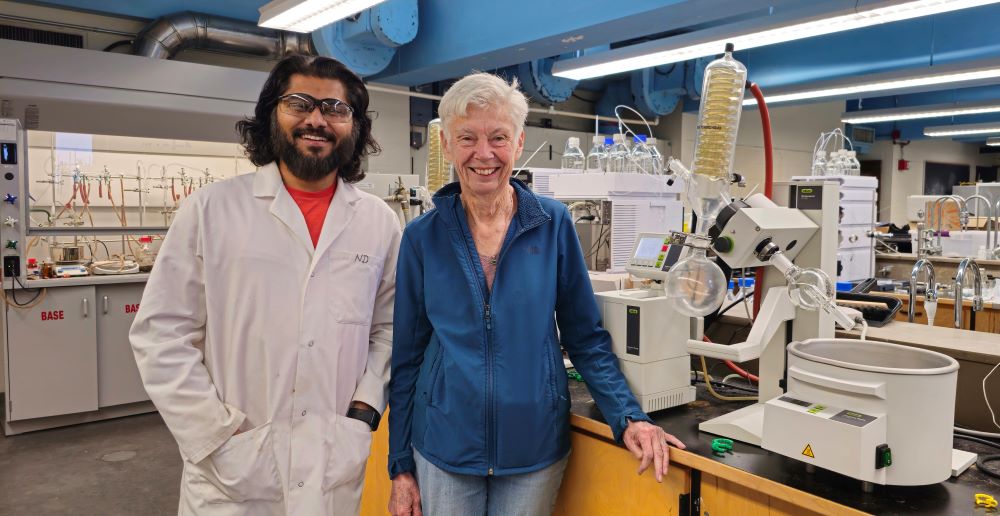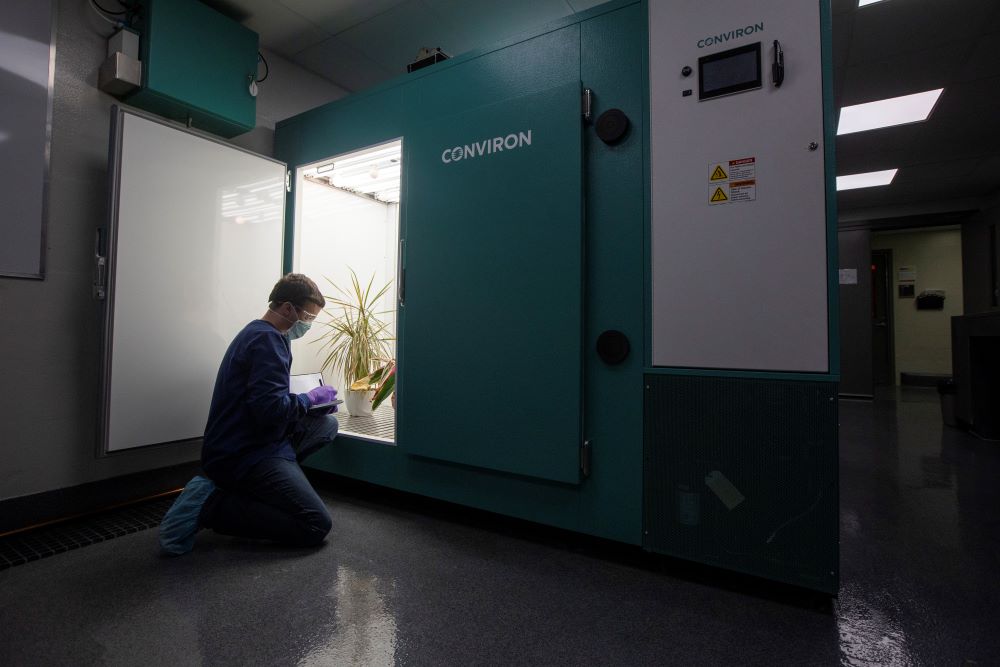
USask researchers link plants and people through advanced medical imaging
Using cutting-edge nuclear imaging technology, medical isotopes produced at the Saskatchewan Cyclotron Facility (Facility) and a deep knowledge of chemistry and biology, two University of Saskatchewan (USask) researchers are uncovering surprising connections between plant science and human health.
By Amy Janzen, Fedoruk Centre CommunicationsDr. Chris Phenix (PhD), associate professor in USask’s College of Arts and Science’s department of chemistry, has spent years developing new nuclear-imaging tracers to study how malfunctioning enzymes in the brain can contribute to diseases like Parkinson’s or Alzheimer’s.
His efforts are gaining momentum around the world as he works with high profile organizations like the Michael J. Fox Foundation. Here at home, Phenix is leading exciting new projects in Saskatchewan that connect human health to plant science, and vice versa.
Alongside Dr. Sue Abrams (PhD), adjunct professor in USask’s College of Arts and Science’s department of chemistry and former National Research Council of Canada organic chemist, Phenix is adapting PET imaging tools to study how plants respond to environmental stressors such as drought.
Phenix holds funding from the Sylvia Fedoruk Canadian Centre for Nuclear Innovation (Fedoruk Centre), which operates the Facility on campus. The Facility provides researchers with access to specialized radiochemistry equipment, the radioactive isotopes required for PET imaging, and PET scanners adapted to study living specimens like small animals and plants.
Originally focused on human health, Phenix’s research evolved after meeting Abrams, leading him back to his agricultural roots in Arcola, Sask, and toward a broader area of research that includes plant science.
“We’re entering a new frontier in plant science by applying nuclear medicine techniques to plants,” said Phenix. “A new and very exciting frontier.”

Phenix and Abrams are exploring the role of abscisic acid (ABA), a key plant hormone that helps plants cope with extreme environmental pressures. The challenge? It breaks down quickly in plants, so its effects are only short-lived. To overcome this, Abrams has developed a library of ABA analogs or molecules that mimic ABA’s function but resist breakdown by plant enzymes.
“Just because a plant has certain genes doesn’t mean we know how it will respond to stress,” said Phenix. “That’s where PET imaging helps. We can study live plants and watch how ABA reacts to environmental stressors. Once we understand how these hormones work, where they’re produced, and how they move around the plant, this could help identify the strains that are more resistant to environmental stresses.”
By tagging ABA with fluorine-18, a radioactive isotope, the team can track how the hormone moves through plants without altering its biology. This enables Phenix and Abrams to observe natural plant responses under stress and compare reactions across different species, like canola or flax.
These innovations are made possible by the same PET imaging tools that Phenix uses to advance his research in neurodegeneration, cancer and other diseases. Now, that same life-saving technology is helping revolutionize agriculture.
In parallel with their academic research, Abrams’ company ABAzyne is developing ABA-based biostimulants that enable plants to withstand low temperature stress, essentially treatments for perennial crops like wine grapes to survive harsh environmental conditions like midwinter freeze and spring frosts.
By understanding how these chemicals affect hormone movement in plants, her team is helping build a new generation of tools for sustainable agriculture.
“Plant hormones have historically been under-studied in terms of chemical tools,” Abrams said. “We’ve relied on genotypes to understand plant behaviour but haven’t had the tools to predict how a plant will respond to its environment. That’s why collaborating with Chris’s team—and their imaging tools—has been so valuable.”
It’s a significant leap forward in understanding how plants respond to drought, frost or even disease.

“If this research pans out,” said Phenix, “we could develop entirely new crop strains that are more resistant to climate-related stress. And with the way our climate is changing, this could be a huge benefit for Saskatchewan’s agricultural industry.”
What’s remarkable is that this work, while focused on plant science, ties directly back to human health.
“As a unique twist that connects back to my work in human health, ABA may also play a role in understanding diseases like type-2 diabetes and cancer,” said Phenix. “Collaborators in Ontario are already testing this idea, and we’re working together to explore what ABA-based treatments could look like in the human body.”
The work Phenix and Abrams are doing doesn’t only advance science, it changes how we think about the intersection of health, agriculture and the environment.
From improving treatments for diseases to creating crops that can withstand harsh weather, this unique to Saskatchewan way of conducting research is equipped to have far-reaching effects that will impact both the scientific community and society at large.
Together, we will undertake the research the world needs. We invite you to join by supporting critical research at USask.
Article re-posted on .
View original article.

